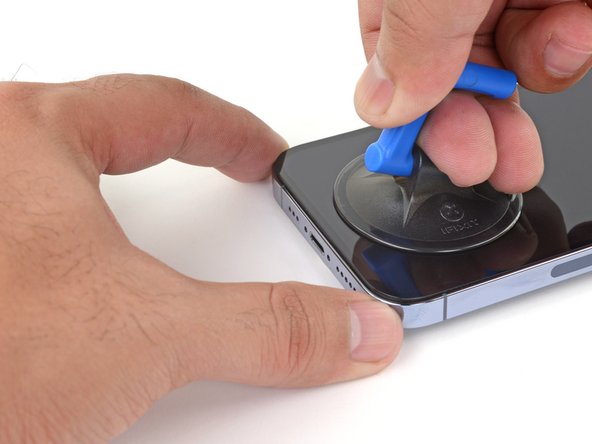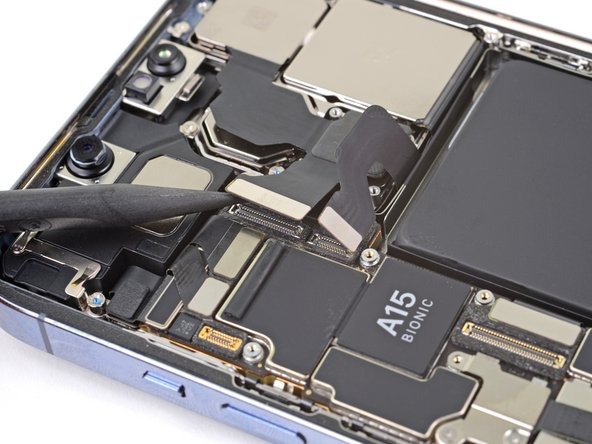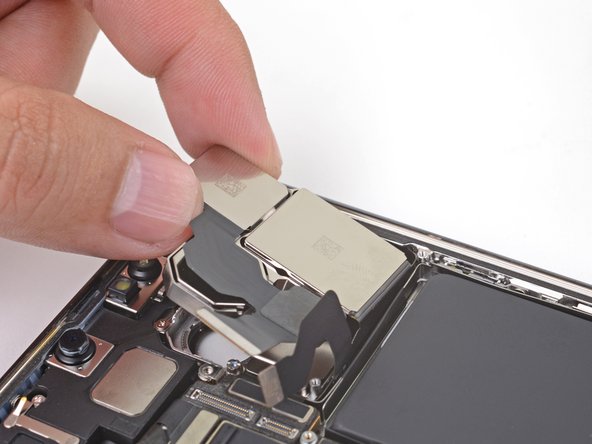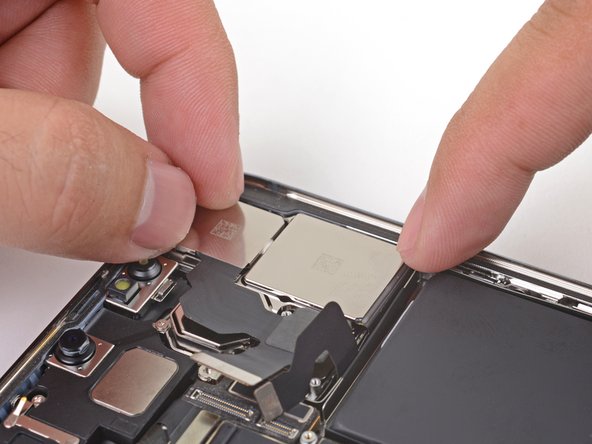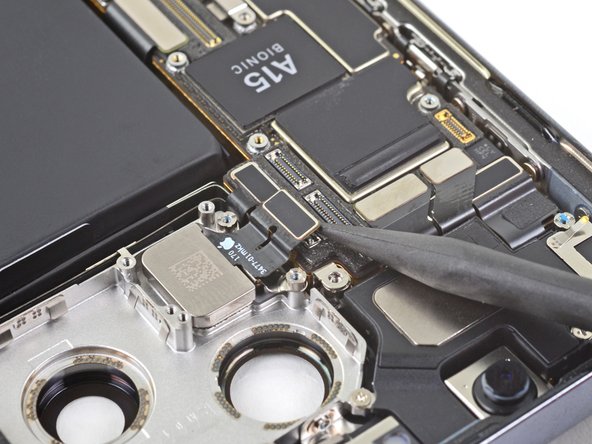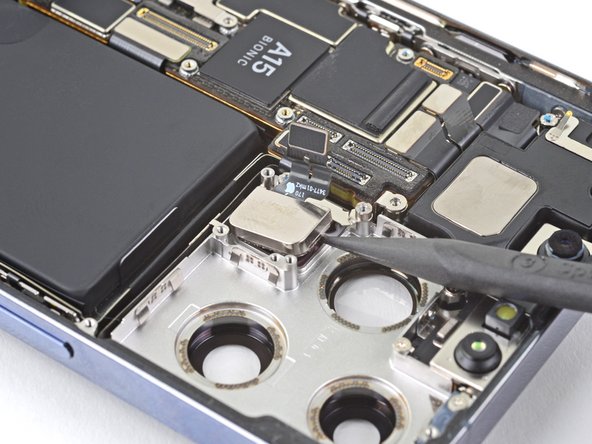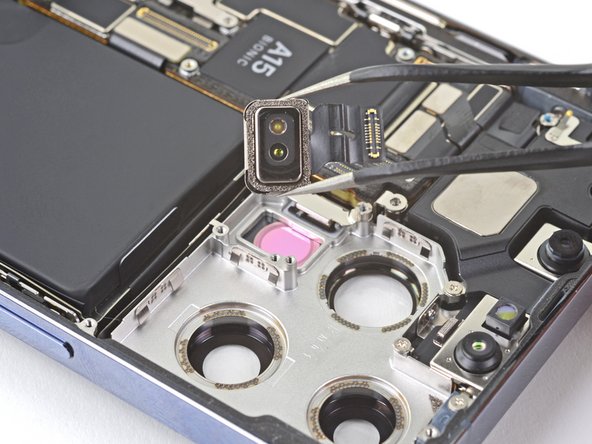iPhone 13 Pro Lidar Sensor Replacement
Duration: 45 minutes
Steps: 35 Steps
Ready to swap out the lidar sensor on your iPhone 13 Pro? Grab your tools and let’s make your phone’s depth-sensing magic work again! Step-by-step, we’ll walk you through the process so your device is back to scanning in no time.
Step 1
Heads up! Before diving in, make sure your iPhone battery is below 25%. A fully charged lithium-ion battery can be a bit dramatic and may catch fire or even explode if it gets punctured. Safety first, folks!
Popping open the iPhone’s display means breaking the waterproof seal, so be ready with replacement seals before you go any further. If you decide to skip replacing them, just be cautious around liquids when putting your iPhone back together. It’s always a good idea to stay dry!
- First things first, let's give your iPhone a little break—power it off before we dive into the disassembly fun!
- Now, grab your trusty pentalobe P2 screwdriver and get ready to remove those two 6.8 mm-long screws at the bottom edge of your iPhone. You've got this!
Step 2
If you push the opening pick in too deep, it might give your device a not-so-gentle poke. To keep things safe, mark your pick so you know exactly how far to go.
Feel free to mark the other corners of your pick with different measurements for extra precision.
Or, stick a coin on your pick about 3 mm from the tip using tape—that way, you’ve got a handy depth guide ready to roll.
- Grab your opening pick and measure about 3 mm from the tip. Use a permanent marker to make a small mark so you know where to start. This little step will help guide the rest of your work!
Step 3
Safety first! Pop on some protective glasses to shield your eyes from any glass bits that might decide to make a break for it during the repair.
Got a cracked screen on your iPhone? No worries! Keep things together and avoid any accidents by taping over the glass. It's like a temporary shield for your phone while you work your repair magic.
If you're in a real pinch, you can stick the suction cup to the screen with a little superglue. Just make sure it’s secure before pulling!
- Cover the iPhone's screen with overlapping strips of clear packing tape until the entire front is protected.
- If the suction cup refuses to stick in the next steps, grab a sturdy piece of tape like duct tape, fold it into a little handle, and use that to lift the screen instead.
Tools Used
Step 4
The next three steps walk you through using the Anti-Clamp, a handy tool we created to make opening your device a breeze. If you’re not using the Anti-Clamp, just skip ahead three steps for another way to open it.
For full details on how to handle the Anti-Clamp, check out this guide.
If your iPhone’s surface feels too slick for the Anti-Clamp to grip, try adding some tape to give it extra hold.
- Give that blue handle a gentle tug backward to set the Anti-Clamp's arms free.
- Slide the arms over the left or right side of your iPhone—whichever feels right.
- Line up the suction cups near the bottom edge, one on the screen side, one on the back.
- Press those cups together to get a solid grip on your phone.
Step 5
- Slide that blue handle forward—arms locked and loaded.
- Spin the handle in a full circle clockwise, or keep going until those cups start to stretch out like they're at yoga class.
- Keep an eye on those suction cups. If they start drifting apart like best friends after summer break, loosen them up and bring them back together.
Step 6
Take it easy, champ! Just twist a quarter turn at a time and chill for a minute between each turn. Let that Anti-Clamp and the magic of time do their thing for you.
Want to master the hair dryer technique? Peep this guide for all the details.
If your Anti-Clamp isn’t giving you enough of a gap, hit that spot with extra heat and give the handle a quarter turn.
- Place your iPhone on a solid surface like a hardcover book so it sits hands-free and flat, making the next steps a breeze.
- Grab a hair dryer and warm up the bottom edge of your iPhone until it’s just a bit too hot to touch—like a warm handshake.
- Give it a minute to let the adhesive loosen and create a small opening gap.
- When there’s enough space thanks to the Anti-Clamp, gently slide an opening pick under the screen’s plastic bezel.
- Skip the next two steps.
Tools Used
Step 7
Keep that hair dryer moving—parking it in one spot too long is a no-go!
- Grab your hair dryer or heat gun and gently warm up the bottom edge of your iPhone for about 90 seconds. You want it just hot enough that the screen feels a bit too warm to touch, but not so hot that it could fry breakfast.
Tools Used
Step 8
The adhesive keeping the screen sealed tight is pretty strong, so it takes a good amount of effort to get that first gap going. If you're finding it tricky, no worries—just apply some more heat, then gently rock the screen up and down. This should help loosen the adhesive enough to create a gap for your tool. Keep going, you've got this!
- Place the suction cup gently on the lower edge of the phone, but steer clear of the glass's very edge. You don't want to be too close!
- Gently pull up on the suction cup with steady, firm pressure. This will create just enough space between the screen and the frame to work with.
- Slide an opening pick into the small gap you’ve made beneath the screen's plastic bezel. It's like gently prying open a door, but for your phone!
Tools Used
Step 9
- Grab a hair dryer and give the right edge of your iPhone (the one with the power button) a nice 90-second warm-up. You’ll know it’s ready when it’s just a little too hot to comfortably touch.
Tools Used
Step 10
Keep your pick shallow—going more than 3 mm deep risks poking parts that should stay un-poked.
- Gently slide the opening pick around the bottom right corner of your iPhone to start loosening that adhesive.
- Keep sliding the pick up along the right edge until you reach the top right corner.
- Leave the pick resting in the top right corner before moving on to the next step.
Step 11
- Grab a hair dryer and warm up the top edge of your iPhone for about 90 seconds, or until the screen feels just a bit too hot to keep your fingers on comfortably.
Tools Used
Step 12
Keep your pick to a maximum of 3 mm, or you might accidentally poke the top sensors. Let's avoid that mishap!
- Gently glide the opening pick around the top right corner of your iPhone to break free that stubborn adhesive.
- Keep the pick wedged in the top left corner while you move on to the next steps.
Step 13
- Grab a hair dryer and warm up the left edge of your iPhone for about 90 seconds, or until the screen feels a little too toasty to touch.
Tools Used
Step 14
Heads up! There are some fragile cables hanging out along the left edge of your iPhone. Avoid sliding your pick in there or those little guys might get hurt.
Step 15
Gently apply twisting pressure, taking it slow and steady.
If the adhesive is being stubborn, warm up the left edge again to loosen it right up.
- Pop a second opening pick into the bottom left corner of your iPhone.
- Gently twist both picks at the same time until the clips on the left edge let go.
Step 16
Hold your horses! Don't go fully separating the display just yet—there are some delicate ribbon cables still hanging on to the iPhone's logic board like it's their best friend.
- Take the suction handle off the screen—your iPhone likes to breathe.
- Spin your iPhone so the right side is facing you, ready for the next move.
- Gently swing the display open from the right edge, kind of like opening a fancy book.
- Prop the display up against something sturdy—no need for hands-on juggling.
- When putting it all back together, set the display in place, line up those clips along the top, and press the top edge first. If it's not snapping in easily, check for any bent clips around the edges before you finish the job.
Tools Used
Step 17
As you work through this repair, be sure to keep track of every screw and put it back exactly where you found it. That way, you'll avoid any unnecessary damage to your device!
- Grab your Y000 screwdriver and carefully remove the three 1.3 mm screws holding down the battery connector cover.
- When putting everything back together, this is a perfect moment to power on your iPhone and make sure all functions are working smoothly before sealing the display. Don’t forget to power it down completely again before moving on.
Step 18
- Gently lift off the battery connector cover to get started.
Step 19
Be careful not to mess up the black silicone seal that hugs this and other board connections. These little guys are the guardians against pesky water and dust, keeping your device safe and sound.
- Grab a spudger (or a clean fingernail, no judgment here) and gently pry the battery connector up from its socket on the logic board.
- Give the connector a little bend away from the logic board to keep it safe from accidentally touching the socket and powering up your phone during the repair.
Tools Used
Step 20
- Gently use the sharp end of a spudger or your clean fingernail to lift the display connector out of its cozy spot on the logic board.
- When it's time to reconnect, take your time! Carefully line up the connectors and press down on one side until you hear that satisfying click. Then, do the same for the other side—just avoid pushing down in the middle. Remember, if things get misaligned, you might bend those pins, and that’s a no-go for your device!
Tools Used
Step 21
- Grab your Y000 screwdriver and send those two 1.1 mm screws (hanging out on the front sensor connector cover) on a little vacation.
- Next up: swap to your Phillips screwdriver and tackle the last two screws securing the cover.
- You'll find one 1.5 mm screw ready to roll.
- And don't forget about the other—the 1.8 mm screw, waiting for its moment in the spotlight.
Step 22
- Lift off the cover for the front sensor connector. Easy does it!
Step 23
- Take the pointy end of your spudger and gently pop off the front sensor assembly cable—easy does it!
Tools Used
Step 24
- Take off the screen carefully.
- When putting everything back together, take a moment here if you want to swap out the waterproof adhesive along the display edges.
Step 25
- Grab your trusty Y000 driver and unscrew the four screws holding that rear-facing camera sensor cover in place.
- Next up, take your Phillips screwdriver and remove the 1.6mm screw.
- Now, go for the three 1.4mm screws that are hanging out there.
- Lastly, finish it off with the one 1.3mm screw. Easy peasy!
Step 26
- Gently pop off the camera cover starting from the side nearest to the logic board, and just like that, it's free!
Step 27
- When popping the camera module cover back in, make sure the right edge's lip sneaks under the phone’s frame. It’s all about that smooth fit!
Step 28
- Gently lift up with the sharp end of a spudger to separate those two camera cables from the logic board. You've got this!
Tools Used
Step 29
- Pop the camera assembly out of the iPhone using the tip of your spudger—give it a gentle lift and let it ride free!
Tools Used
Step 30
- Pop those rear cameras out—they’ve done their job, and now it’s time for a break!
Step 31
- When putting things back together, slide those two camera cables right into the gap between the battery’s upper wall and the lower camera wall—like threading a needle, but with way cooler tech.
Step 32
- Grab your trusty Y000 screwdriver and let's tackle those screws on the lidar cover! Here’s the scoop: you've got two 1.4 mm screws to unscrew, along with a single 1.3 mm screw. Easy peasy!
Step 33
- Carefully lift off the lidar cover.
Step 34
- Grab the spudger, aim for the pointed end, and gently pop the lidar cable off the logic board.
Tools Used
Step 35
- Double-check that your new part matches the original—sometimes you'll need to move over little bits or peel off protective stickers before popping it in.
- Put everything back together by simply reversing these steps.
- Got some old tech parts lying around? Make sure to drop them off at an R2 or e-Stewards certified recycler.
- If things didn’t quite go your way, don’t stress! Try some basic troubleshooting, or if you’re stuck, you can always schedule a repair.
























